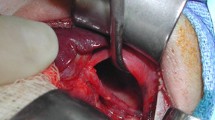Abstract
Object
The purpose of this study is to evaluate the outcome of our therapeutic strategy for antenatally diagnosed congenital diaphragmatic hernia (ADCDH).
Methods
We treated 61 cases of ADCDH according to our strategy. Prostaglandin E1 was required to be maintained the patency of the ductus arteriosus (PDA) in 39 cases (Group I) while it was not administered in 22 cases (Group II). Left ventricular end-diastolic dimension (LVDD) and Tei index were measured with echocardiography on days 0, 2, and 7 after birth. Radical surgery was performed on all cases by day 2.
Results
On day 0, Group I showed smaller LVDD and Tei index than those in Group II. Between day 0 and day 2, these parameters increased significantly in Group I, but not in Group II. On day 7, no significant difference in these parameters was observed between the two groups. Five patients died of cardiac and respiratory failure, resulting in a survival rate of 92 %.
Conclusion
Our therapeutic strategy improves the clinical outcome of ADCDH. This can be attributed to two factors: earlier surgery resulting in improved LV function. The latter attenuates pulmonary hypertension and maintains PDA with a consequent decrease in right ventricular afterload to compensate for the low cardiac output resulting from PDA.



Similar content being viewed by others
References
The Neonatal Inhaled Nitric Oxide Study Group (NINOS) (1997) The neonatal inhaled nitric oxide study group: inhaled nitric oxide and hypoxic respiratory failure in infants with congenital diaphragmatic hernia. Pediatrics 99:838–845
Germain JF, Farnoux C, Pinquier D et al (1996) Can blood gas values predict pulmonary hypoplasia in antenatally diagnosed congenital diaphragmatic hernia? J Pediatr Surg 31:1634–1639
Reyes C, Chang LK, Waffarn F et al (1999) Delayed repair of congenital diaphragmatic hernia with early high- frequency oscillatory ventilation during preoperative stabilization. J Pediatr Surg 33:1010–1016
Nagata K, Usui N, Kanamori Y et al (2013) The current profile and outcome of congenital diaphragmatic hernia: a nationwide survey in Japan. J Pediatr Surg 48:738–744
The Congenital Diaphragmatic Hernia Study Group (2007) Defect size determines survival in infants with congenital diaphragmatic hernia. Pediatrics 120:e651–e657
Tsao K, Lally KP (2008) The Congenital Diaphragmatic Hernia Study Group: a voluntary international registry. Semin Pediatr Surg 17:90–97
Vogel M, Mcelhinney DB, Marcus E, Morash D et al (2010) Significance and outcome of left heart hypoplasia in fetal congenital diaphragmatic hernia. Ultrasound Obstet Gynecol 35:310–317
Hadi MB, Desmond B (2007) Pulmonary hypertension in congenital diaphragmatic hernia. Semin Pediatr Surg 16:126–133
Inamura N, Kubota A, Nakajima T et al (2005) A proposal of new therapeutic strategy for antenatally diagnosed congenital diaphragmatic hernia. J Pediatr Surg 40:1315–1319
Kamata S, Ishikawa S, Usui N et al (1996) Prenatal diagnosis of congenital diaphragmatic hernia and pulmonary hypoplasia and therapeutic strategy. Pediatr Surg Int 11:512–517
Garcia AV, Fingeret AL, Thirumoorthi AS et al (2013) Lung to head ratio in infants with congenital diaphragmatic hernia does not predict long term pulmonary hypertension. J Pediatr Surg 48(1):154–157. doi:10.1016/j.jpedsurg.2012.10.031
Okuyama H, Kubota A, Oue T et al (2002) Inhaled nitric oxide with early surgery improves the outcome of antenatally diagnosed congenital diaphragmatic hernia. J Pediatr Surg 37:1188–1190
Tei C, Dujardin KS, Hodge DO et al (1996) Doppler index combining systolic and diastolic myocardial performance: clinical value in cardiac amyloidosis. J Am Coll Cardiol 28:658–664
Momma K, Ando M, Mori Y et al (1992) Hypoplasia of the lung and heart in fetal rats with diaphragmatic hernia. Fetal Diagn Ther 7:46–52
Allan LD, Irish MS, Glick PL (1996) The heart in diaphragmatic hernia. Clin Perinatol 23:795–811
Rudolph AM, Heymann MA (1970) Circulatory changes during growth in the fetal lamb. Circ Res 26:289–299
Rasamen J, Wood DC, Weiner S et al (1996) Role of the pulmonary circulation in the distribution of human fetal cardiac output during the second half of pregnancy. Circulation 94:1068–1073
Inamura N, Taketazu M, Smallhorn JF et al (2005) Left ventricular myocardial performance in the fetus with severe tricuspid valve disease. Am J Perinatol 22:91–97
Author information
Authors and Affiliations
Corresponding author
Rights and permissions
About this article
Cite this article
Inamura, N., Kubota, A., Ishii, R. et al. Efficacy of the circulatory management of an antenatally diagnosed congenital diaphragmatic hernia: outcomes of the proposed strategy. Pediatr Surg Int 30, 889–894 (2014). https://doi.org/10.1007/s00383-014-3574-y
Accepted:
Published:
Issue Date:
DOI: https://doi.org/10.1007/s00383-014-3574-y




